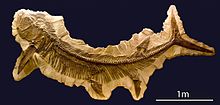Xiphactinus
|
Xiphactinus Temporal range: Albian–Maastrichtian |
|
|---|---|
 |
|
| Xiphactinus fossil from the National Museum of Natural History | |
| Scientific classification | |
| Kingdom: | Animalia |
| Phylum: | Chordata |
| Class: | Actinopterygii |
| Superorder: | Osteoglossomorpha |
| Order: | Ichthyodectiformes |
| Family: | Ichthyodectidae |
| Subfamily: | Ichthyodectinae |
| Genus: |
Xiphactinus Leidy, 1870 |
| Species | |
|
|
| Synonyms | |
|
Portheus molossus Cope, 1871 |
|
Portheus molossus Cope, 1871
Xiphactinus (from Latin and Greek for "sword-ray") is an extinct genus of large (4.5 to 6 metre; 15 to 20 feet long) predatory marine bony fish that lived during the Late Cretaceous. When alive, the fish would have resembled a gargantuan, fanged tarpon (to which it was, however, not related). The species Portheus molossus described by Cope is a junior synonym of X. audax. Skeletal remains of Xiphactinus have come from Kansas (where the first Xiphactinus fossil was discovered during the 1850s), and Cretaceous formations all over the East Coast (most notably Georgia, Alabama, North Carolina, and New Jersey) in the United States, as well as Europe, Australia, Canada and Venezuela.
Species of Xiphactinus were voracious predatory fish. At least a dozen specimens of X. audax have been collected with the remains of large, undigested or partially digested prey in their stomachs. In particular, one 13 feet (4.0 m) fossil specimen was collected by George F. Sternberg with another, nearly perfectly preserved 6 feet (1.8 m) long ichthyodectid Gillicus arcuatus inside of it. The larger fish apparently died soon after eating its prey, most likely owing to the smaller fish prey's struggling and rupturing an organ as it was being swallowed. This fossil can be seen at the Sternberg Museum of Natural History in Hays, Kansas.
...
Wikipedia
